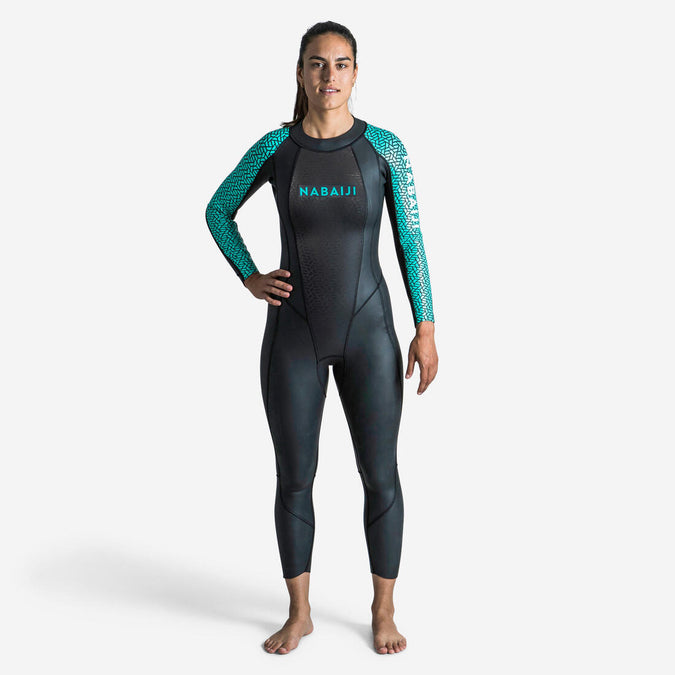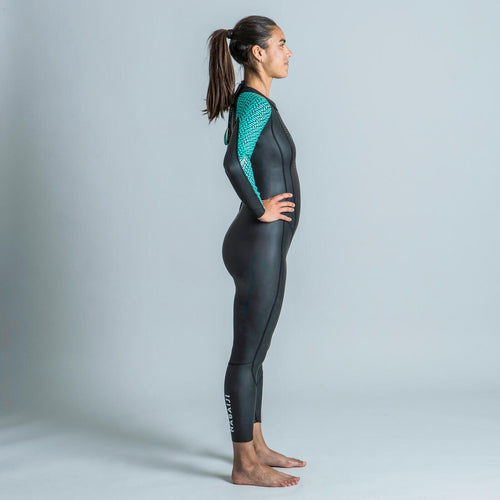Product Colors and Sizes




NABAIJI
Women’s open water swimming neoprene wetsuit - OWS 500 2/2 black turquoise
Regular price:
Sale price: 84.000 OMR
8577308
| Quantity | % Discount |
|---|---|
Get your discount once you reach the limit quantity in your cart.
Our design teams developed this open water swimming wetsuit for swimming in temperate water, while optimising its glide and buoyancy.
This open water swimming suit is made entirely from glideskin neoprene for optimal glide in the water! 2.5 mm thick over the chest and legs and 2 mm over the arms.
Select a size
Sale price:
Sale price:
Product Features

Additional Product informations
Composition
Foam
- 100% Rubber
Main fabric - Outer layer
- 100% Polyurethane
Main fabric - Inner layer
- 14% Elastane
- 86% Polyamide
Recommendations for use:
To prevent chafing around the neck and other areas liable to friction, apply Vaseline or a mixture of 50% Vaseline and 50% lanolin.
Component
Arms: 2 mm GLIDE SKIN neoprene Chest, back and legs: 2.5 mm GLIDE SKIN neoprene FLATLOCK seams: not waterproof
What is the difference between a surfing wetsuit and an open water swimming wetsuit?
Surfing wetsuits are made from standard neoprene, with a woven fabric outer layer. This material is very tough but soaks up water. It is suitable for surfing. Open water swimming wetsuits are made partly or entirely from glideskin neoprene. This waterproof material is more hydrodynamic. It is also more fragile. Open water swimming wetsuits are therefore strictly designed for the practice of swimming
Why is it so difficult to get into a wetsuit?
Getting into a neoprene wetsuit may seem like mission impossible, especially for those who have never used one. Neoprene wetsuits need to be a tight fit, as this is what prevents water from getting in. If the wetsuit is too big, swimmers will be more exposed to the cold, as well as to skin irritation as the wetsuit will move over the course of their session.
Fitting advice:
The Glide-Skin component used in this wetsuit is very flexible and stretchy, but also more fragile. When putting it on, do not use your fingernails and do not pull too hard. Put your arms and legs in gradually.
I feel the muscular effort differently when wearing a neoprene wetsuit. is this normal?
If you’re enjoying your first open-water sessions with a wetsuit, it’s completely normal to feel it more or differently in your muscles. This is because the sleeves offer added flotation for your arms, and so you have to use “extra” strength to plunge your arm into the water. This sensation will ease off and disappear after a few sessions.
What are the different types of neoprene: standard and glideskin?
Neoprene is made up of 3 layers: - Inner layer: mesh. - Middle layer: foam. - Outer layer: standard or glideskin fabric. Standard neoprene has a woven fabric outer layer. This material is very tough but soaks up water and is more difficult to repair. Glideskin neoprene has a polymer outer layer. This has the benefit of being more hydrodynamic and also waterproof. It is more fragile but is easily repaired with neoprene glue.
Product Reviews
There are no reviews yet for this product
Product Recently viewed

Women’s open water swimming neoprene wetsuit - OWS 500 2/2 black turquoise
Your location: City, ST
Please enter a valid city with state or zipcode. Example: San Francisco, CA or 94101
Order online for
Heavy products return policy
If you return a product you will receive a refund for the purchase price plus any applicable sales taxes, less any non-refundable charges.
Decathlon will cover all shipping costs associated with your return except for items excluded from our return policy such as bikes, basketball hoops, snowboards, surfboards, tents, and other larger / heavier items.
Return costs for heavy products:
| Weight Thresholds | Shipping within California | Shipping outside of California |
|---|---|---|
| > 9 lbs | $20.00 | $25.00 |
| > 30 lbs | $50.00 | $65.00 |
| > 100 lbs | $100.00 | $125.00 |
| > 200 lbs | $200.00 | $230.00 |
If you return a product at any of our store locations, we will gladly help you find the best alternative product or refund you on the spot.











